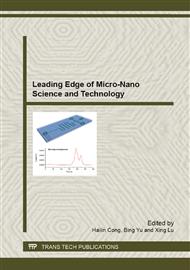p.283
p.292
p.296
p.302
p.307
p.311
p.316
p.325
p.331
A Simple, Green Synthesis of Photochromic, Monoclinic Tungsten Oxide Fiber
Abstract:
The fiber shaped monoclinic tungsten oxides with high preferential orientation has been synthesized by dialysis and aging treatment at room temperature, of the white precipitates prepared from HCl acidified (NH4)10W12O41 solution. The microstructure evolution of the above tungsten oxide was studied by SEM. The morphology of the powder changed from irregularity to shuttle plate-like during short time dialysis in pure water, and the butterfly shape was obtained after long time treatment. It was found that the nano-particles were rearranged to form nano-fibers on the surface of the butterfly shaped oxide as a function of aging time when the butterfly powder was kept in the original mother liquor. Compared to butterfly oxide, the morphology of fibers exhibited much improved thermal stability. The photochromic property of the tungsten oxide with different morphology was studied. The response time in color change after irradiated by the UV output of a 30 W mercury lamp is 20 s in inert atmosphere and the recovery time in bleach is about 2 months.
Info:
Periodical:
Pages:
307-310
Citation:
Online since:
March 2013
Authors:
Keywords:
Price:
Сopyright:
© 2013 Trans Tech Publications Ltd. All Rights Reserved
Share:
Citation:


